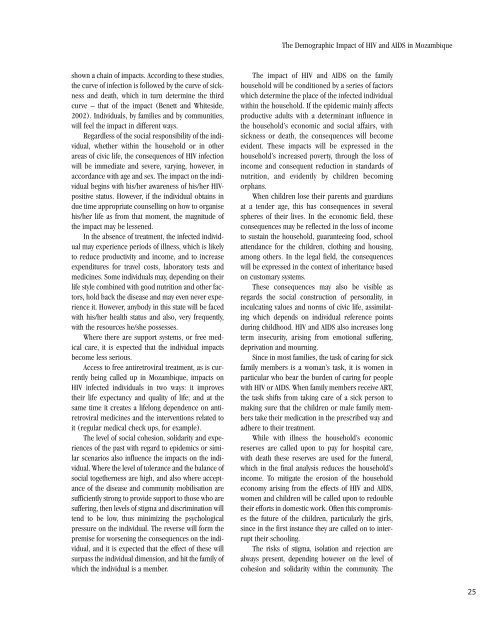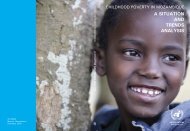Mozambique National <strong>Human</strong> <strong>Development</strong> Report 2007Box 4.1It has been 25 years since the HIV virus was reported as thecause of the AIDS disease.Several countries affected by the AIDS pandemic haveundertaken praiseworthy efforts to establish methods ofgathering statistical information for the purposes mentionedabove. As from the 1980s, many countries introduced epidemiologicalsurveillance systems to gather HIV data amongpregnant women. This method is based on the assumptionthat pregnant women are a sexually active, easily identified,accessible and stable population group. Thus HIV prevalencein the total population has been estimated based on datafrom this group.Very recently, in order to complement the informationobtained by the method mentioned above, population surveys(men, women and children) have also been used to estimatethe level of HIV prevalence, through blood and/or saliva samples.Among the African countries that have already carried outthis kind of survey are South Africa, Burkina Faso, Cameroon,Ghana, Kenya, Mali, Rwanda, Senegal, Tanzania, Uganda andZambia.Methodology currently used in MozambiqueThe Ministry of Health has set up an HIV EpidemiologicalSurveillance system, through Sentinel Sites located in selectedhealth units throughout the country. The system began in 1988with just 4 sentinel sites located in urban areas. This numberwas gradually increased to include rural areas and strengthenthe urban ones, so as to obtain increasingly representativeprevalence rates. As from 2001, the gathering of data has beenundertaken in 36 sentinel sites. The technical staff linked to thematter has recommended not expanding the number in future.The data are gathered in a maximum period of 3 months.At each site 300 pregnant women aged between 15 and 49who present themselves consecutively for their first ante-natalconsultation are selected. As is practice in other countries, thisinformation serves as the basis to estimate the HIV prevalenceand the demographic impact of HIV and AIDS for the total population.Calculating the provincial prevalence rates is undertakenby weighting the prevalence rate observed by the adult population(15-49 years) of the district, the regional rates by weightingthe provincial rates by the adult population of the province;and the national rate by weighting the regional rates by therespective adult population of the region.Estimates of HIV and AIDS prevalence:Epidemiological Surveillance versus Sero-prevalence SurveyOnly a quarter of the 144 districts in Mozambique possessSentinel Sites. To obtain prevalence rates for all districts, someassumptions have been made:• It is assumed that in the districts with Sentinel Sites, theprevalencerate observed is representative of the entire district;• To each district without a Sentinel site is attributed, as areference, the prevalence rate from another with a Sentinelsite, in accordance with established criteria of similarity.Added value of the new methodologyAlthough the results of HIV prevalence obtained via samples ofpregnant women are broadly acceptable, there remain someuncertainties and scepticism. The first concerns the representativenature of the samples used, as pregnant women with ahigh level of education are generally under-represented.Furthermore the high rate of pregnancy and births among HIVnegativewomen, compared with HIV-positive ones, is anotherfactor which generates some polemic.The second, which flows from the first, concerns the criteriaused to extrapolate from the HIV prevalence of the pregnantwomen to the total population and different geographicallevels. It is thought that that the combination of these two limitationsmay introduce distortions into the estimates of thedynamic of the HIV epidemic among the population.The introduction of the new methodology should not beseen as replacing the previous one, but as complementing it. Theliterature on the subject indicates that there is no single methodthat forecasts better estimates of HIV prevalence. The two methodsunder analysis are mutually complementary, since epidemiologicalsurveillance seeks to estimate the trend, while populationsurveys contribute to improving the calculation of the levels ofthe epidemic. Thus, the results of the surveys are used to calibrate(adjust) those obtained from epidemiological surveillance.To corroborate the above, recent studies show that HIVestimates based on results from the two methods in generalshow no significant differences.Finally, the survey may also contribute to examining thedeterminants of regional differences in relating information onthe sexual behaviour of the interviewees with HIV prevalence.For the survey to be relevant, in the current debate, its samplemust be representative not only at national, but also at provinciallevel. Otherwise a rare opportunity to consolidate estimateson the prevalence of the epidemic will be wasted.Impact of HIV and AIDS onindividuals and familiesUnderstanding the impact of the HIV and AIDS pandemicpresupposes understanding the transformations inthe socio-cultural and economic environment that itcreates with its immediate effect in terms of human morbidityand mortality. Without the HIV and AIDS pandemicany country in southern Africa would currently displaya different population structure and composition.In Mozambique, the impact of the disease onindividuals, families and communities has not beenwell studied. References to work oriented towardsbetter understanding this dynamic and directing thedevelopment of sectors in the light of the scenariosthat the epidemic presents are limited to a few isolatedcases of sector analyses of limited coverage. Thusgeneralizing from them is not recommended. What iscertain, however, is that as the epidemic spreads longitudinally,it becomes difficult to predict, qualify orquantify what its impact might be.Meanwhile, in low income countries, wherepoverty is the common denominator, studies have24
The Demographic Impact of HIV and AIDS in Mozambiqueshown a chain of impacts. According to these studies,the curve of infection is followed by the curve of sicknessand death, which in turn determine the thirdcurve – that of the impact (Benett and Whiteside,2002). Individuals, by families and by communities,will feel the impact in different ways.Regardless of the social responsibility of the individual,whether within the household or in otherareas of civic life, the consequences of HIV infectionwill be immediate and severe, varying, however, inaccordance with age and sex. The impact on the individualbegins with his/her awareness of his/her HIVpositivestatus. However, if the individual obtains indue time appropriate counselling on how to organisehis/her life as from that moment, the magnitude ofthe impact may be lessened.In the absence of treatment, the infected individualmay experience periods of illness, which is likelyto reduce productivity and income, and to increaseexpenditures for travel costs, laboratory tests andmedicines. Some individuals may, depending on theirlife style combined with good nutrition and other factors,hold back the disease and may even never experienceit. However, anybody in this state will be facedwith his/her health status and also, very frequently,with the resources he/she possesses.Where there are support systems, or free medicalcare, it is expected that the individual impactsbecome less serious.Access to free antiretroviral treatment, as is currentlybeing called up in Mozambique, impacts onHIV infected individuals in two ways: it improvestheir life expectancy and quality of life; and at thesame time it creates a lifelong dependence on antiretroviralmedicines and the interventions related toit (regular medical check ups, for example).The level of social cohesion, solidarity and experiencesof the past with regard to epidemics or similarscenarios also influence the impacts on the individual.Where the level of tolerance and the balance ofsocial togetherness are high, and also where acceptanceof the disease and community mobilisation aresufficiently strong to provide support to those who aresuffering, then levels of stigma and discrimination willtend to be low, thus minimizing the psychologicalpressure on the individual. The reverse will form thepremise for worsening the consequences on the individual,and it is expected that the effect of these willsurpass the individual dimension, and hit the family ofwhich the individual is a member.The impact of HIV and AIDS on the familyhousehold will be conditioned by a series of factorswhich determine the place of the infected individualwithin the household. If the epidemic mainly affectsproductive adults with a determinant influence inthe household’s economic and social affairs, withsickness or death, the consequences will becomeevident. These impacts will be expressed in thehousehold’s increased poverty, through the loss ofincome and consequent reduction in standards ofnutrition, and evidently by children becomingorphans.When children lose their parents and guardiansat a tender age, this has consequences in severalspheres of their lives. In the economic field, theseconsequences may be reflected in the loss of incometo sustain the household, guaranteeing food, schoolattendance for the children, clothing and housing,among others. In the legal field, the consequenceswill be expressed in the context of inheritance basedon customary systems.These consequences may also be visible asregards the social construction of personality, ininculcating values and norms of civic life, assimilatingwhich depends on individual reference pointsduring childhood. HIV and AIDS also increases longterm insecurity, arising from emotional suffering,deprivation and mourning.Since in most families, the task of caring for sickfamily members is a woman’s task, it is women inparticular who bear the burden of caring for peoplewith HIV or AIDS. When family members receive ART,the task shifts from taking care of a sick person tomaking sure that the children or male family memberstake their medication in the prescribed way andadhere to their treatment.While with illness the household’s economicreserves are called upon to pay for hospital care,with death these reserves are used for the funeral,which in the final analysis reduces the household’sincome. To mitigate the erosion of the householdeconomy arising from the effects of HIV and AIDS,women and children will be called upon to redoubletheir efforts in domestic work. Often this compromisesthe future of the children, particularly the girls,since in the first instance they are called on to interrupttheir schooling.The risks of stigma, isolation and rejection arealways present, depending however on the level ofcohesion and solidarity within the community. The25
















